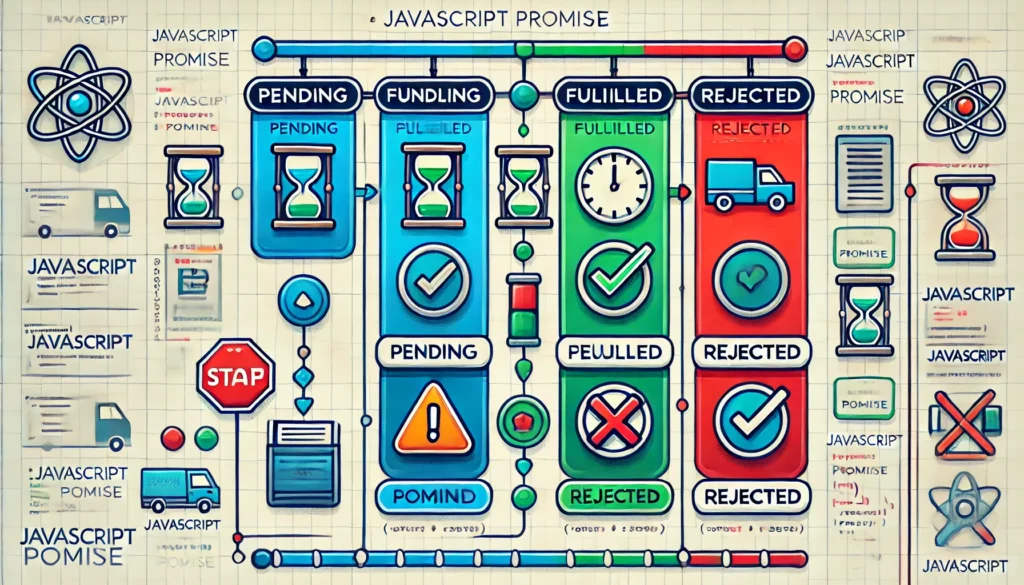Internal Workings of Async/Await and Promises

Picture This: Conquering Asynchronous Challenges
Visualize building a social media dashboard where users can post updates and receive notifications in real-time. At first, everything runs seamlessly. But soon, managing data fetching, error handling, and API call chains becomes a nightmare of nested callbacks and indecipherable error logs. The app slows down, and debugging feels like solving a labyrinth. Frustrating, right?
Welcome to the world of JavaScript asynchronous programming, where tools like async/await and Promises bring order to chaos. These features turn convoluted async operations into clean, readable code. But how do they function? What’s happening under the hood?
Mastering Promises: The Core of Asynchronous JavaScript
What Exactly Are Promises?
A Promise is a vital JavaScript feature that represents the eventual result of an asynchronous process. It provides a structured way to handle tasks like fetching data or performing delayed computations.
Picture it like placing an order at a café:
- You order your coffee (the async task).
- The barista hands you a receipt (the Promise), symbolizing your order.
- When your coffee is ready, the receipt is resolved, allowing you to enjoy your drink (resolved value).
- If something goes wrong, like the café running out of coffee beans, the receipt is rejected, requiring you to handle the situation (error management).

Promise States
A Promise can be in one of three states:
- Pending: The task is still in progress.
- Fulfilled: The task completed successfully, returning a result.
- Rejected: The task failed, resulting in an error.
Example
const fetchData = new Promise((resolve, reject) => {
setTimeout(() => {
resolve("Data fetched successfully");
}, 1000);
});
fetchData.then(data => console.log(data))
.catch(error => console.error(error));How Promises Operate Behind the Scenes
- Executor Function: When a Promise is initialized, its executor function is executed immediately, using
resolveandrejectas arguments. - Microtask Queue: After a Promise resolves or rejects, the corresponding
.thenor.catchis queued as a microtask. - Event Loop: Microtasks are processed before the next event loop cycle, giving them a higher execution priority.
Async/Await: A Simplified Approach to Promises
What is Async/Await?
Async/await offers an elegant way to work with Promises, enabling developers to write asynchronous code that resembles traditional synchronous logic. This makes the code more understandable and maintainable.
An async function always returns a Promise, while the await keyword pauses the function until the associated Promise resolves.
Basic Syntax
async function fetchData() {
try {
const data = await getData();
console.log(data);
} catch (error) {
console.error(error);
}
}How Async/Await Works Internally
- Execution of Async Functions: When an
asyncfunction is called, it begins executing synchronously until it encounters the firstawaitstatement. - Await Halts Execution: The
awaitkeyword pauses the function while the Promise is pending, allowing other tasks to run. Once the Promise resolves, the function resumes. - Error Handling: Errors within an
asyncfunction can be managed usingtry-catch, making debugging and error resolution easier.
Example
async function fetchWeather() {
try {
const response = await fetch("https://api.weather.com");
const data = await response.json();
console.log(data);
} catch (error) {
console.error("Failed to fetch weather data:", error);
}
}The Event Loop, Microtasks, and Macrotasks: Explained
Understanding the event loop is crucial for grasping asynchronous behavior in JavaScript.
How the Event Loop Works
The event loop ensures JavaScript performs non-blocking operations efficiently. Imagine it as a conveyor belt where main tasks (macrotasks) and side tasks (microtasks) are processed in a specific order to keep things running smoothly.
Microtasks vs. Macrotasks
- Microtasks: Include Promise callbacks and
MutationObservertasks. - Macrotasks: Include
setTimeout,setInterval, and I/O operations.
Execution Priority: All microtasks are executed before the next macrotask begins.
Example: Event Loop in Action
console.log("Start");
setTimeout(() => {
console.log("Macrotask: setTimeout");
}, 0);
Promise.resolve().then(() => {
console.log("Microtask: Promise");
});
console.log("End");
//Output:
//vbnetCopyEditStart
//End
//Microtask: Promise
//Macrotask: setTimeoutKey Differences Between Promises and Async/Await
| Feature | Promises | Async/Await |
|---|---|---|
| Syntax | Uses .then and .catch | Resembles synchronous logic |
| Readability | Moderate | High |
| Error Handling | .catch | try-catch |
| Debugging | Slightly harder | Simplified with clear traces |
Practical Applications
1. Fetching API Data
async function fetchData(url) {
const response = await fetch(url);
const data = await response.json();
return data;
}
2. Handling Chained Async Operations
async function fetchUserDetails(userId) {
try {
const user = await fetchUser(userId);
const posts = await fetchUserPosts(user.id);
return { user, posts };
} catch (error) {
console.error("Error fetching user details:", error);
}
}3. Sequential vs. Parallel Operations
Sequential Execution:
async function sequentialFetch() {
const data1 = await fetchData1();
const data2 = await fetchData2();
console.log(data1, data2);
}Parallel Execution:
async function parallelFetch() {
const [data1, data2] = await Promise.all([fetchData1(), fetchData2()]);
console.log(data1, data2);
}Avoiding Common Async Mistakes
Common Errors
- Blocking the Event Loop: Avoid long-running synchronous tasks inside async functions.
- Unhandled Rejections: Always handle rejections using
.catchortry-catch.
Best Practices
- Use
Promise.allfor independent tasks to optimize performance. - Avoid placing
awaitinside loops; prefer batch processing withPromise.all. - Always include error handling in async workflows.
Conclusion
To excel at modern JavaScript, mastering async/await and Promises is non-negotiable. These tools not only make async programming more manageable but also improve the overall readability and maintainability of your code. Learn more about Promises on the MDN Web Docs.
Try incorporating these techniques in your next project and let us know how they worked for you. Together, let’s create innovative, efficient code! For more tips and insights, visit jsupskills.dev.

 Install jsUpskills app on your home screen!
Install jsUpskills app on your home screen!